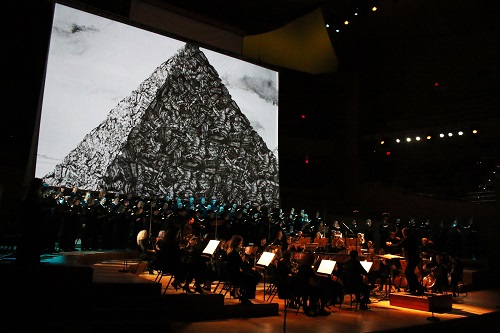 United States Handel, Israel in Egypt: Los Angeles Master Chorale and Orchestra / Grant Gershon (conductor), Walt Disney Concert Hall, Los Angeles, 11.2.2018. (DD)
United States Handel, Israel in Egypt: Los Angeles Master Chorale and Orchestra / Grant Gershon (conductor), Walt Disney Concert Hall, Los Angeles, 11.2.2018. (DD)

Cast:
Elissa Johnson (soprano)
Anna Schubert (soprano)
Shabnam Kalbasi (mezzo-soprano)
Niké St. Clair (mezzo-soprano)
Jon Lee Keenan (tenor)
David Dong-Geun Kim (bass-baritone)
Chung Uk Lee (bass)
Visuals: Kevork Mourad
Israel in Egypt is the first English oratorio from Handel’s late – and miraculous – creative period, 1738 to 1752, the last hurrah in a remarkably fertile artistic life. It is an historic interval that includes a number of Handel’s masterpieces, including Semele, Susanna, Judas Maccabaeus, Theodora, Belshazzar, Joseph, Jephtha and, of course, Messiah. The works were intended for concert hall performance rather than in-church liturgy, and they often contained sequences replete with theatrical flourishes and stagy effects. Cue the thunder!
The Los Angeles Master Chorale and Orchestra presented this underperformed masterwork in the dramatically congenial confines of the Walt Disney Concert Hall. (The Master Chorale has committed to presenting of all of Handel’s oratorios, having initiated the series with Alexander’s Feast in 2016). Solo parts were given over to individuals selected from the Chorale’s deep roster of singers.
This is a large-scale composition, often episodic, with much highly specific narrative and picturesque text, and there are few organizations that can best the redoubtable LA Master Chorale with it. Their dramatic instincts are so securely honed and shaped by Director Grant Gershon that the keening and crying of the Israelites were palpable, their burdens aurally onerous and the plagues visited upon them filled with appropriate fear and dread: a fugal chorus of highly chromatic blood, a ‘ribbit’ rhythmic figuration with the plague of frogs, the triple plague of buzzing flies, lice and locusts, and a ghastly finish with hailstones, fire, foggy darkness and the deaths of Egypt’s firstborn children.
The last section of the oratorio’s drama is concerned with the destruction of Pharaoh’s army in the Red Sea, with a glorious chorus of praise and thanks to the Lord. These are all familiar stories from the Old Testament, and the Handel rendering was nothing if not highly descriptive. Indeed, ‘over the top’ was what I heard whispered from a couple sitting behind me.
Over the top or not, this was a performance with muscle and sinew. Gershon included the original Charles Jennens opening text, ‘Lamentations of the Israelites for the Death of Joseph’, which was dropped by Handel in 1739 and not fully revived until the twentieth century. The scene is set in a dark, Stygian atmosphere, and the Master Chorale’s interpretation did nothing to dispel the gloomy ambience.
It is in Part II: ‘The Exodus’ that this oratorio takes flight (pun quite intended). Here the wonderfully evocative music vividly and specifically describes the horrors visited by the Lord upon the Egyptians in their attempt to keep the Israelites in bondage. Tenor Jon Lee Keenan served well in his herald’s role, while mezzo-soprano Shabnam Kalbasi shone in her early aria. The telling of the litany of plagues that were visited upon the Egyptians fell largely to the Master Chorale chorus, and their extraordinary musical pliability was on full display as they chronicled one horror after another. Dramatic sensibility and seamless malleability are among the chorale’s greatest assets, and these were more than evident.
The section given over to the ‘thick darkness’ is among the creepier of the oratorio’s moments, of which there are many. I assumed that it was a depiction of the dense and heavy fog that darkened the Egyptian landscape, and the music from this section of the score would have been comfortably at home in most horror films.
Following the intermission, the voice – if not the person – of Moses as channeled by Handel becomes the dominant vocal champion of the Israelites, retelling the chronicle of the triumph over the Egyptians and giving copious thanks to God for the victory. The music is less telling in its drama, though it does sound like a sort of precursor to what will become Handel’s crowning masterpiece, Messiah, a mere three years later. Again the Master Chorale was its own miraculous entity in terms of presence. Sopranos Elissa Johnson and Anna Schubert delivered a robust ‘The Lord is my strength and my song’, accompanied by a determined bass line in the cellos that numbered among the finest moments in this production.
Syrian Armenian artist Kevork Mourad’s imagery, projected above the stage, was meant to provide a visual ‘improvisational element’ to the music. These projections – some drawn, some animated and some produced in real time with the artist’s hand movements emerging and coalescing in the background – provided an interesting perspective that both enhanced and distracted.
As a final note, not all choristers are up to the demands of soloing in a concert of this order: Disney is a resonant and deep hall, and not everyone has the ability to fill it. There were more than a few less-than-clean entries, the soloists in the duo and trio sections were not always equally balanced, the occasional intonation problem was far from a Biblical plague but more than a flea bite and, in a few instances, the orchestra sounded under-rehearsed.
But despite these few, mostly minor, caveats, the singers, soloists and instrumentalists served as powerful advocates for Handel’s music and message.
Douglas Dutton